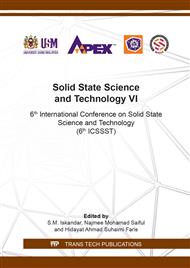p.122
p.127
p.137
p.142
p.147
p.153
p.163
p.168
p.177
Fabrication of InxGa1-xN/GaN Multi-Quantum well Structure for Green Light Emitting Diode on Patterned Sapphire Substrate by Metal Organic Chemical Vapour Deposition
Abstract:
Abstract. In an effort to successfully fabricate InGaN-based for green emitting devices on patterned sapphire substrate, the indium composition in InxGa1-xN/GaN multi-quantum well structure is crucial because lower indium composition will shift the wavelength towards ultraviolet region. In this study, 5 micrometre of undoped GaN epilayer was deposited as a buffer layer prior to the growth structure. 6 pairs of InGaN/GaN multi-quantum well structure grown by metal organic chemical vapour deposition (MOCVD). In this research, the indium to gallium composition ratio was 9:1. The crystal and optical properties of the samples were characterized using field effect atomic force microscopy, high resolution x-ray diffraction, and photoluminescence spectroscopy.
Info:
Periodical:
Pages:
147-152
Citation:
Online since:
April 2019
Keywords:
Price:
Сopyright:
© 2019 Trans Tech Publications Ltd. All Rights Reserved
Share:
Citation:


